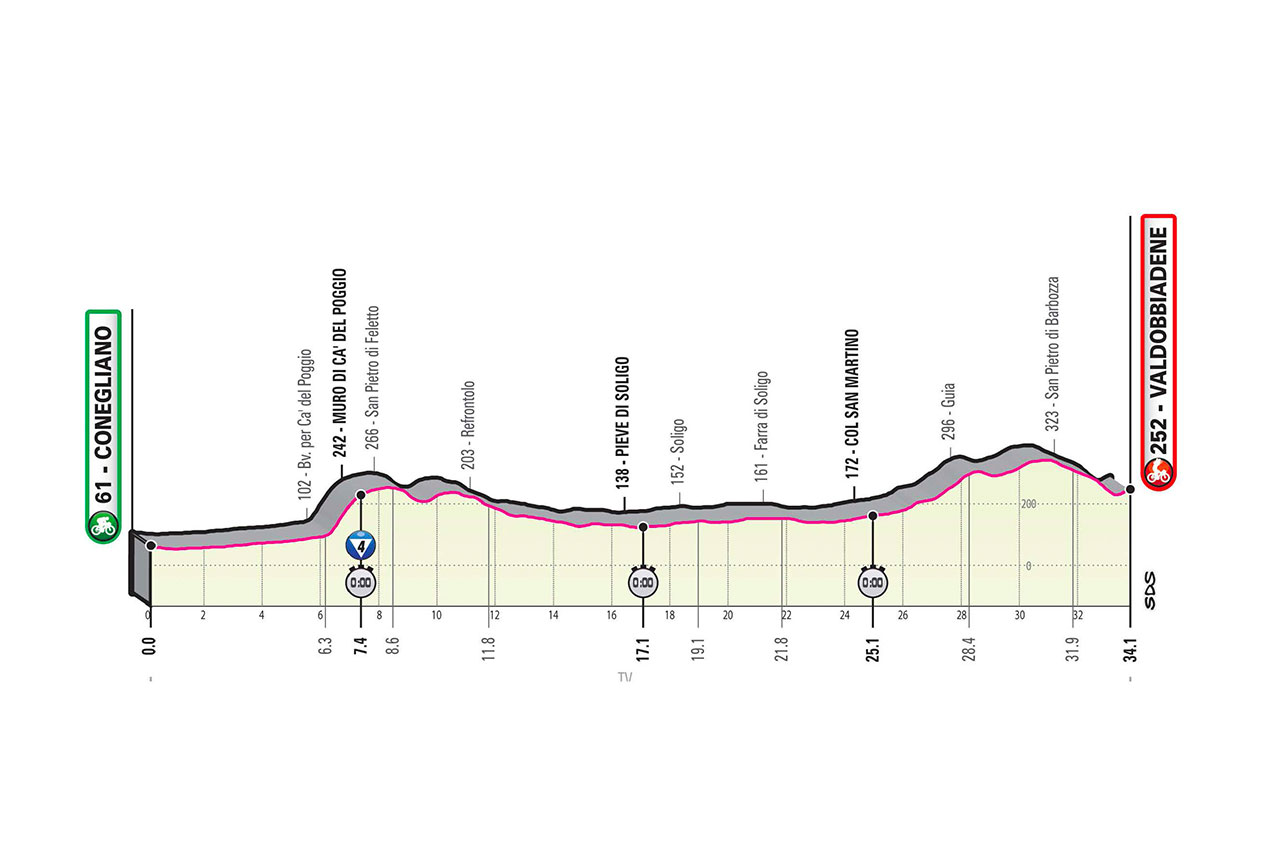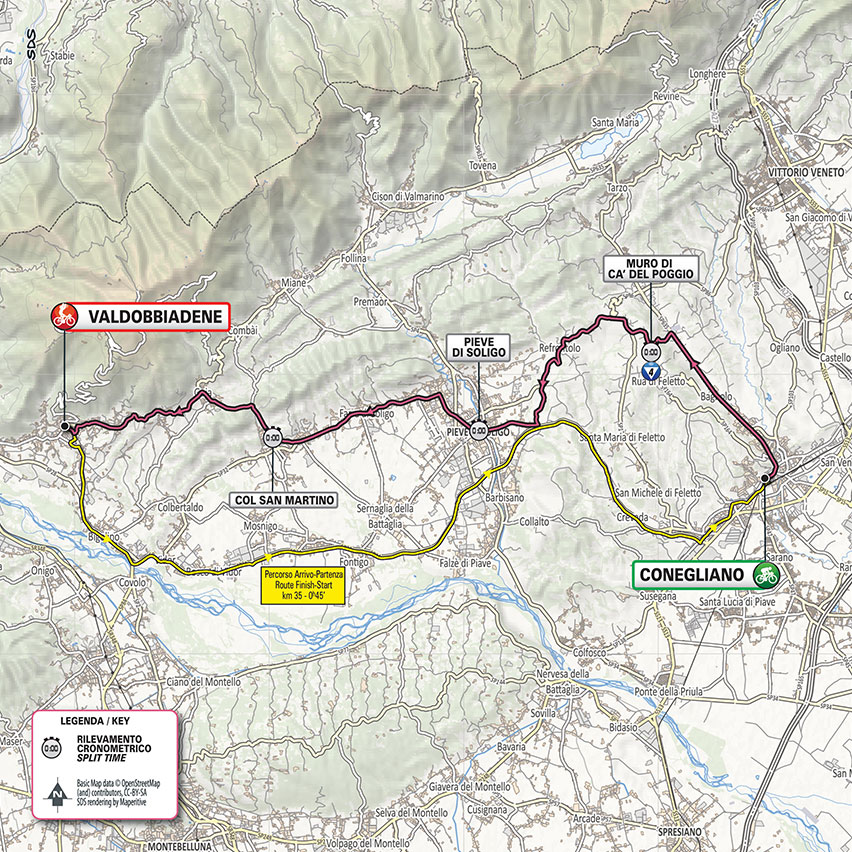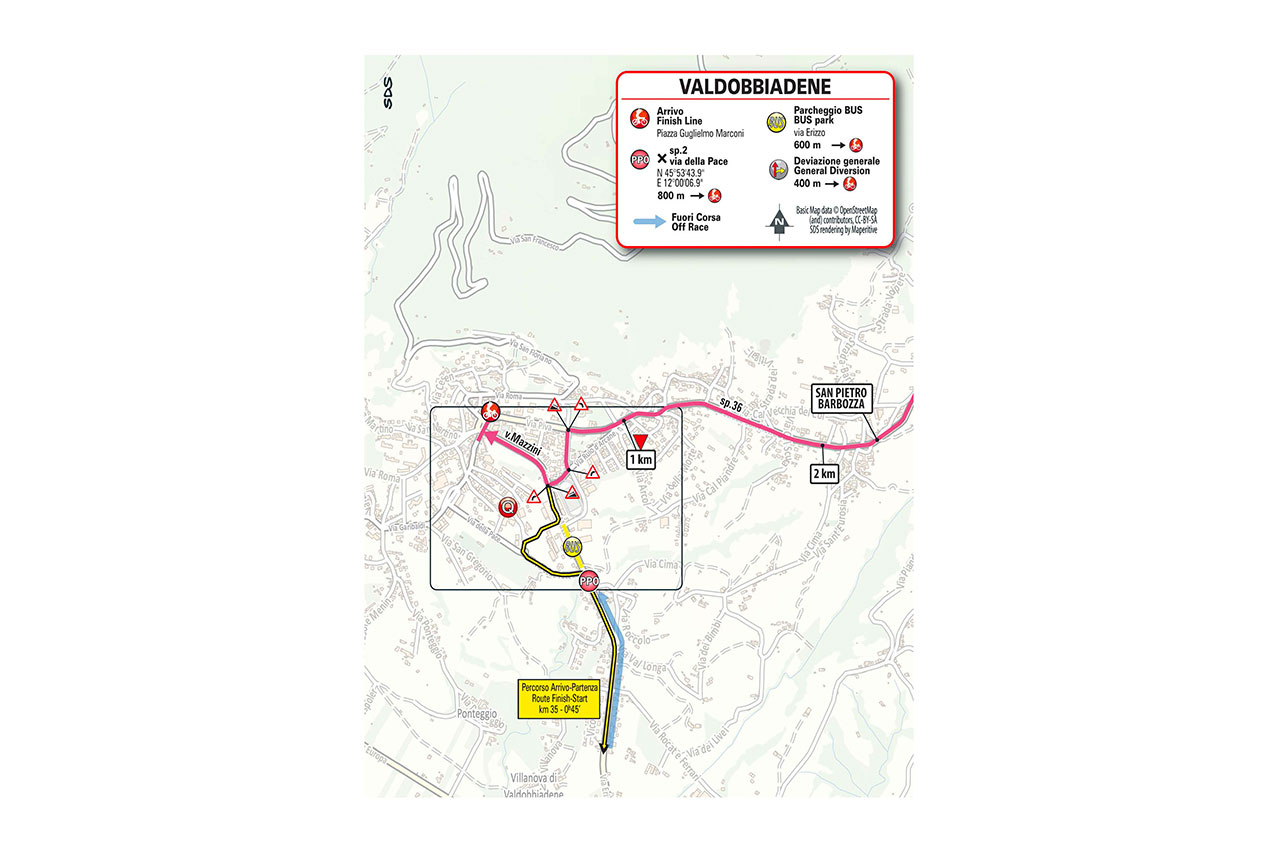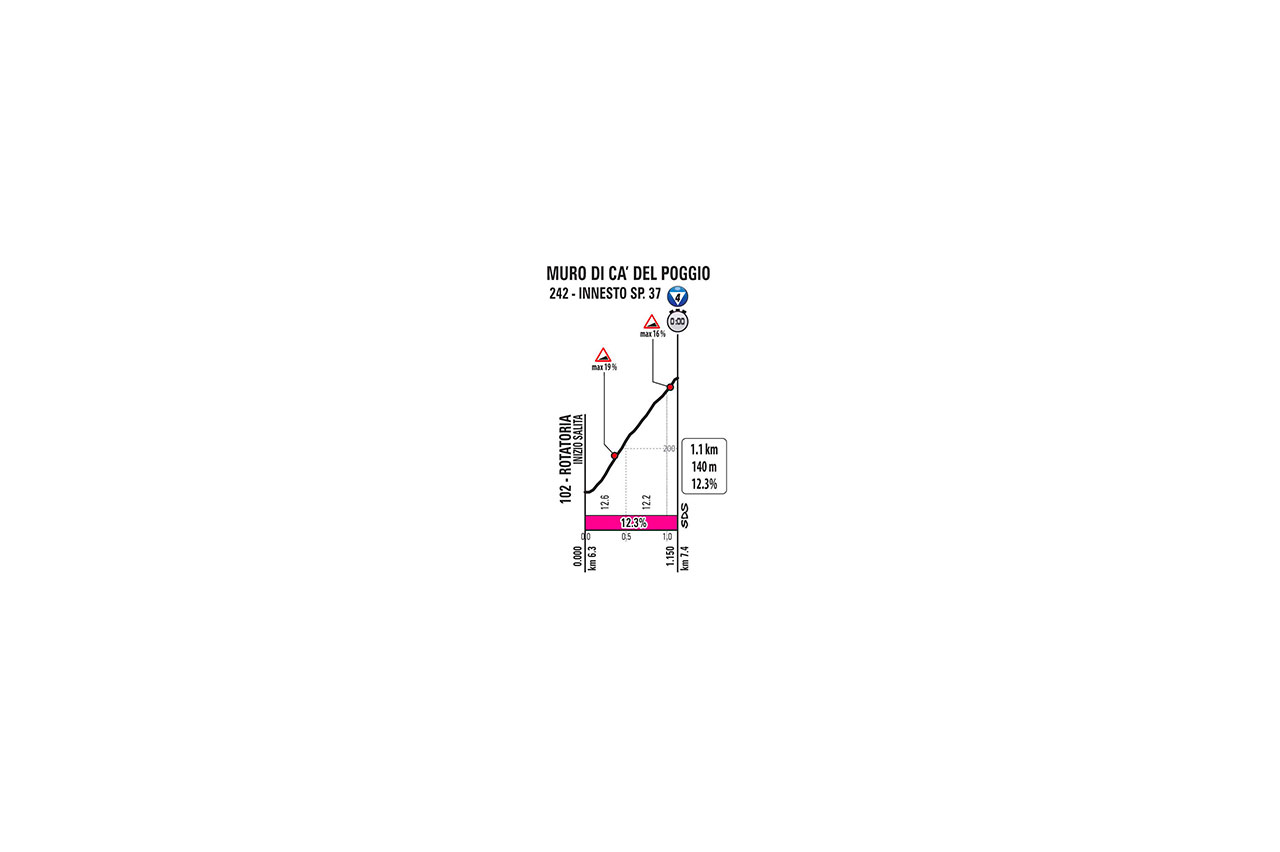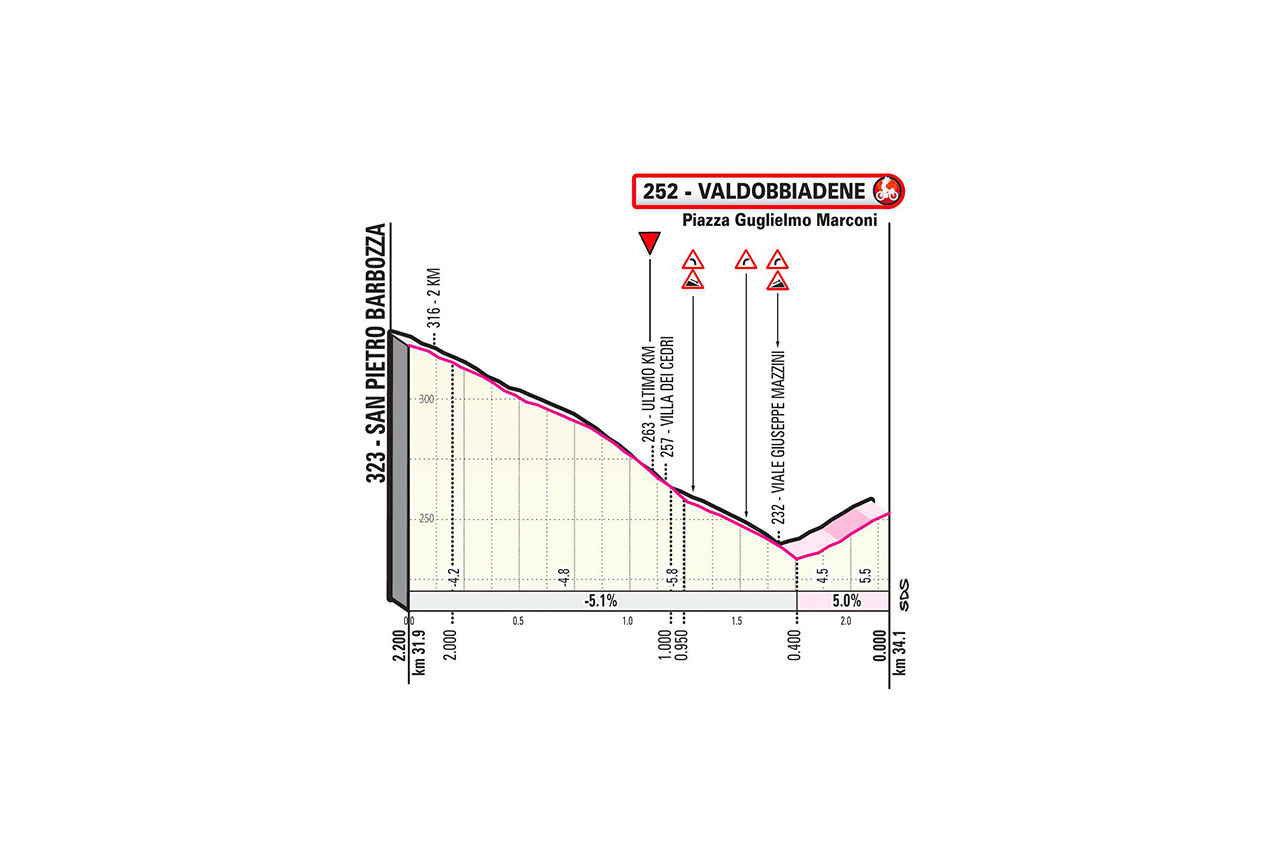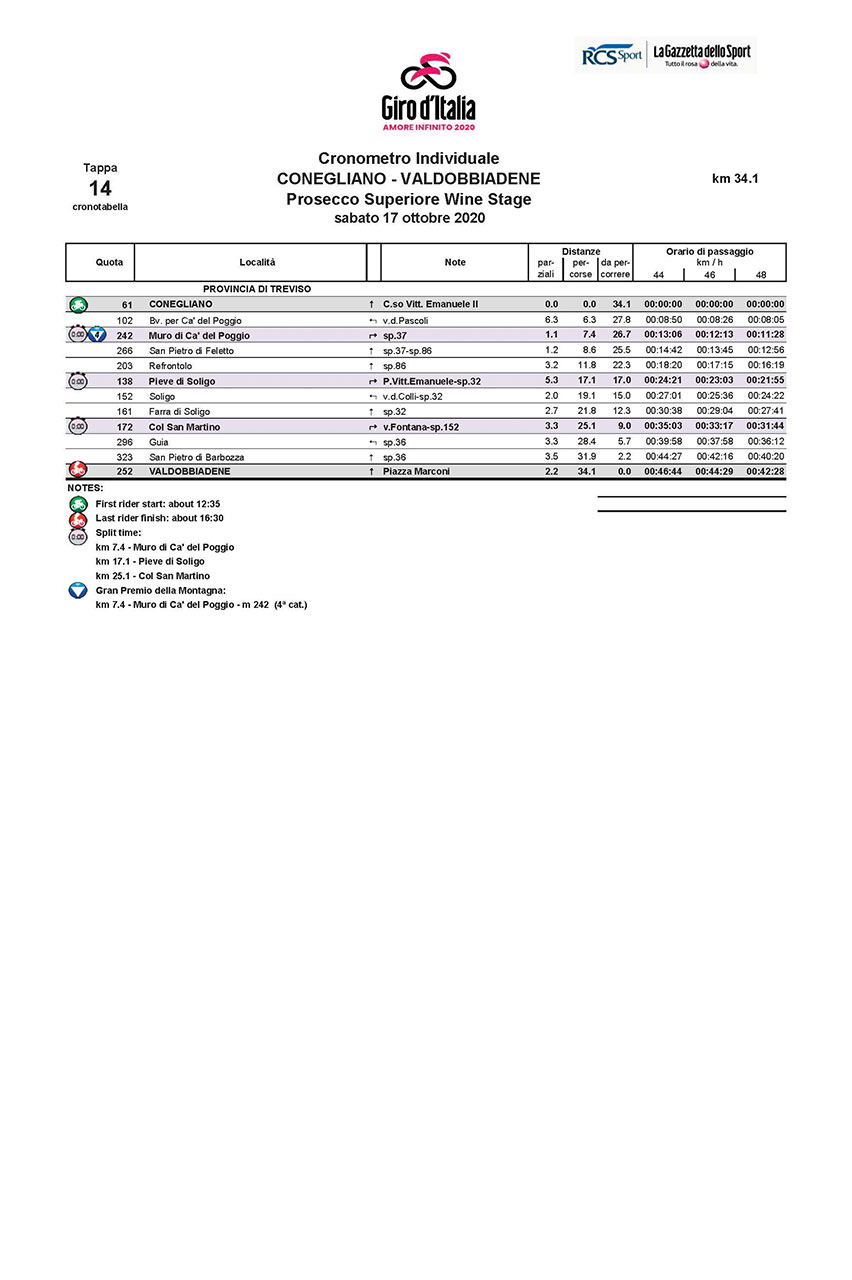profile
map
technical info
The Route
This challenging time trial stage is raced against the background of the Prosecco vineyards. The route (34.1 km) is demanding, and features one categorised climb after just some 7 km, with gradients topping out at 19% (Muro di Ca’ del Poggio). The stage course then winds its way across the hills, undulating continuously along moderately narrow yet perfectly-surfaced roads.
Final kilometres
The final 3 km run downhill all the way up to 400 m from the finish line. With 750 m to go, the route takes a sharp bend to the left, then turns right with 500 m to go (still descending), and then turns again 400 m before the finish, leading into the 300 m long home straight. The stage homes in on a 5.5% incline, on 6 m tarmac.
start / finish
climb detail
final kilometres
itinerary timetable
tourist info
Host city:
Conegliano
Overview
Conegliano is a walled town built around its medieval castle, whose Renaissance splendour is still etched in its noble palaces and painted façades.The starting point for a possible route is the city of Conegliano, birthplace of the painter Cima da Conegliano (1459-1518), considered to be one of the great Masters of the Renaissance.
Food
The spit roast is part and parcel of the gastronomic traditions of the area. Its true home is the commune of Pieve di Soligo, which organises a series of events in its honour every year. In 2010 it was recognized as a “Certified Traditional Product”.
Sausages and Cold Cuts
A typical snack in the zone is to enjoy a glass of Conegliano Valdobbiadene Prosecco Superiore with a plate of sliced cold cuts and white homemade bread. We draw your attention in particular to Ossocollo, a salami prepared with meat from the neck of the pig and Sopressa Trevigiana, a salami with soft, gently flavoured flesh.
Cheeses, whether matured or young, have always played a part in the hospitality of the Treviso area, either served simply with bread or polenta or on a cheeseboard, accompanied by a glass of wine. The most distinctive types are Morlacco del Grappa, “Formajo Imbriago” a cheese that matures in the grape pomace and the Alpine cheeses in general, particularly those from Mount Cesen. Casatella Trevigiana D.O.P. is a very traditional creamy cheese, made in the past by farmers’ wives with the small amount of milk they had available. Its name derives from the Latin “caseus” and so signifies a small round of non-matured cheese. It has a fresh, delicate, milky aroma and a gentle flavour (also reminiscent of milk) with faintly acidulous hints.
The hilly zones and mountain foothills are full of areas in which mushrooms have always proliferated: particularly popular are “i brisot” (porcini), served in a salad or sautéed, made into a sauce, cooked in oil, garlic and parsley, stewed or fried. Also much appreciated are “i ciodet”, traditionally cooked pan-fried and served with polenta, or used in sauces for serving with past a, in risottos or in soups.
THE PROSECCO SUPERIORE DOCG
The story of Prosecco Superiore DOCG began in the hills of Conegliano Valdobbiadene: a small but high-quality area lying 50 kilometres north of Venice and 100 from the Dolomites.
Here wine production dates back to ancient times, and over the course of the centuries the continuous labour of man has modified the morphology of the countryside, creating unique scenery characterized by vineyards that literally create a patchwork on its hillsides.
The success story of Conegliano Valdobbiadene Prosecco began in 1876, the year that Italy’s First School of Winemaking was founded in Conegliano. This was followed in 1923 by the Institute for Viticultural Experimentation. Thanks to these centres for study and research, the vine-growers learnt to plant vineyards high up in the hills, in particular around Valdobbiadene, where cultivating vines is defined as “heroic”: here viticulture is exhausting and difficult because of the slopes, some of which have gradients of up to 70% and which force growers to carry out vineyard operations almost exclusively by hand. Indeed, to tend these vineyards up to 800 hours’ work is required each year, compared to 150 on the plain.
In the cellar, on the other hand, the so-called Italian Method for making sparkling wines was being perfected, which calls for refermentation in autoclaves (large pressurized tanks). Thanks to the research of the School of Winemaking, this Italian or Charmat Method was fine-tuned to such a degree as to be defined as a specific technique for producing Conegliano Valdobbiadene Prosecco Superiore.
Throughout the 20th century, then, the characteristics of the two towns that embrace the zone became ever more focused: Conegliano was its “cultural” capital and Valdobbiadene its “production” capital.
In 1962 a group of 11 producers created the Consortium for the Protection of Prosecco from Conegliano Valdobbiadene, drawing up production regulations designed to safeguard the quality and image of their wines. In 1969 this Consortium obtained Denominazione di Origine Controllata status for Prosecco Superiore and in 2009 that of Denominazione di Origine Controllata e Garantita, the highest recognition of quality for Italian wines. Even in the past the producers decided to highlight the name of the region, placing before that of “Prosecco” the name of the area’s most significant towns: “Conegliano Valdobbiadene Prosecco Superiore”.
The story of the Denomination continues to the present day, urged on by its success on both the national and international markets, and it never shirks caring for the environment; Conegliano Valdobbiadene is the largest area in Europe that has banned the use of glyphosate, the most discussed chemical substance in recent years, which continues to be used in many Italian and European agricultural areas. It is the result of a long and precise synergistic work and great cooperation between local administrations of the 15 municipalities of the Denomination and the Consortium of Protection.
The result of this balance between attention to the market and that for the countryside is the entire zone’s recognized UNESCO World Heritage Site.
Points of interest
In its historic centre the Duomo (Cathedral) is well worth a visit: it contains one of the artist’s most famous works, the “Madonna and Child Enthroned with Angels and Saints”.
Of the façade of the Duomo one can only glimpse a cross that rises from the roof, because the rest is covered by the building known as the Scuola dei Battuti, which is to all intents and purposes an integral part of the ecclesiastical complex: together they constitute a centre for art that boasts some of the most important paintings in the whole of the Conegliano area.
Valdobbiadene (Prosecco Superiore Wine Stage)
Overview
Valdobbiadene is an important town in the area, of ancient origins, full of interesting religious buildings as well as typical Venetian-style villas
Food
The spit roast is part and parcel of the gastronomic traditions of the area. Its true home is the commune of Pieve di Soligo, which organises a series of events in its honour every year. In 2010 it was recognized as a “Certified Traditional Product”.
A typical snack in the zone is to enjoy a glass of Conegliano Valdobbiadene Prosecco Superiore with a plate of sliced cold cuts and white homemade bread. We draw your attention in particular to Ossocollo, a salami prepared with meat from the neck of the pig and Sopressa Trevigiana, a salami with soft, gently flavoured flesh.
Cheeses, whether matured or young, have always played a part in the hospitality of the Treviso area, either served simply with bread or polenta or on a cheeseboard, accompanied by a glass of wine. The most distinctive types are Morlacco del Grappa, “Formajo Imbriago” a cheese that matures in the grape pomace and the Alpine cheeses in general, particularly those from Mount Cesen. Casatella Trevigiana D.O.P. is a very traditional creamy cheese, made in the past by farmers’ wives with the small amount of milk they had available. Its name derives from the Latin “caseus” and so signifies a small round of non-matured cheese. It has a fresh, delicate, milky aroma and a gentle flavour (also reminiscent of milk) with faintly acidulous hints.
The hilly zones and mountain foothills are full of areas in which mushrooms have always proliferated: particularly popular are “i brisot” (porcini), served in a salad or sautéed, made into a sauce, cooked in oil, garlic and parsley, stewed or fried. Also much appreciated are “i ciodet”, traditionally cooked pan-fried and served with polenta, or used in sauces for serving with past a, in risottos or in soups.
This typically autumnal fruit is a type of chestnut, which is heart-shaped and has a striated, pale brown shell and sweet flesh. “Marroni” are usually roasted on top of the stove, but they may also be baked in the oven or boiled. They are widely used by pastry chefs and in the preparation of desserts and jams.
Drink
The story of Prosecco Superiore DOCG began in the hills of Conegliano Valdobbiadene: a small but high-quality area lying 50 kilometres north of Venice and 100 from the Dolomites.
Here wine production dates back to ancient times, and over the course of the centuries the continuous labour of man has modified the morphology of the countryside, creating unique scenery characterized by vineyards that literally create a patchwork on its hillsides.
The success story of Conegliano Valdobbiadene Prosecco began in 1876, the year that Italy’s First School of Winemaking was founded in Conegliano. This was followed in 1923 by the Institute for Viticultural Experimentation. Thanks to these centres for study and research, the vine-growers learnt to plant vineyards high up in the hills, in particular around Valdobbiadene, where cultivating vines is defined as “heroic”: here viticulture is exhausting and difficult because of the slopes, some of which have gradients of up to 70% and which force growers to carry out vineyard operations almost exclusively by hand. Indeed, to tend these vineyards up to 800 hours’ work is required each year, compared to 150 on the plain.
In the cellar, on the other hand, the so-called Italian Method for making sparkling wines was being perfected, which calls for refermentation in autoclaves (large pressurized tanks). Thanks to the research of the School of Winemaking, this Italian or Charmat Method was fine-tuned to such a degree as to be defined as a specific technique for producing Conegliano Valdobbiadene Prosecco Superiore.
Throughout the 20th century, then, the characteristics of the two towns that embrace the zone became ever more focused: Conegliano was its “cultural” capital and Valdobbiadene its “production” capital.
In 1962 a group of 11 producers created the Consortium for the Protection of Prosecco from Conegliano Valdobbiadene, drawing up production regulations designed to safeguard the quality and image of their wines. In 1969 this Consortium obtained Denominazione di Origine Controllata status for Prosecco Superiore and in 2009 that of Denominazione di Origine Controllata e Garantita, the highest recognition of quality for Italian wines. Even in the past the producers decided to highlight the name of the region, placing before that of “Prosecco” the name of the area’s most significant towns: “Conegliano Valdobbiadene Prosecco Superiore”.
The story of the Denomination continues to the present day, urged on by its success on both the national and international markets, and it never shirks caring for the environment; Conegliano Valdobbiadene is the largest area in Europe that has banned the use of glyphosate, the most discussed chemical substance in recent years, which continues to be used in many Italian and European agricultural areas. It is the result of a long and precise synergistic work and great cooperation between local administrations of the 15 municipalities of the Denomination and the Consortium of Protection.
The result of this balance between attention to the market and that for the countryside is the entire zone’s recognized UNESCO World Heritage Site.
Points of interest
The parish church of Guia, attributed to Canova; the 15th century Church of San Gregorio; Villa dei Cedri, a former factory in the 19th century.
Carrying on along our route, one arrives in the “Cru” sub-zone of the Conegliano Valdobbiadene DOCG: the area of Cartizze, with its 108 hectares of vineyards, that gives its name to the celebrated sparkling wine produced on the most precipitous slopes of Santo Stefano, Saccol and San Pietro di Barbozza, where the Valdobbiadene Wine Brotherhood also has its headquarters.
In the commune of Vidor, particularly worthy of note is the abbey dating back to the beginning of the 12th century: it was destroyed during the Second World War, but has now been partly restored. On the site where the Castle used to be, an event takes place every year in September called the “Palio di Vidor”, which commemorates the many assaults suffered by the fortress.
At Farra di Soligo a visit to the Church of San Virgilio, surrounded by vineyards on the hill of Col San Martino, allows one to enjoy the beauty of all the neighbouring countryside. Built around the year 1100, it has two large external clocks and a sturdy Romanesque campanile. The single nave inside is embellished with a series of wooden trusses and frescoes from the 15th century.
From Valdobbiadene you can set off for one of the most evocative areas of the area: the northernmost hills of the denomination, where the vineyards, cultivated on steep slopes, create a particularly suggestive scenery. The route reaches the towns of Miane and Campea where you will feel immersed in one of the most enchanting and precious landscapes of the area. Finally, still moving from Valdobbiadene, eastwards you will reach Follina, where you can visit the Cistercian Abbey of Santa Maria di Follina, built on a previous Benedictine building in the 12th century, still today the seat of monks who keep its activity alive
Top video
































